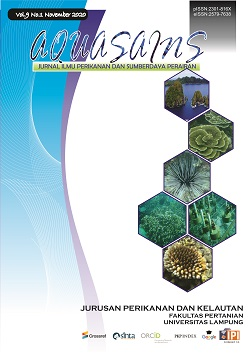Coral Reef Fishes Biodiversity In Pahawang Island,Pesawaran District Lampung
DOI:
https://doi.org/10.23960/aqs.v9i1.p887-892 Abstract View: 476
Abstract View: 476
Abstract
The components of coral reef ecosystem can be described by the unique regulation in community level. Coral reef fishes use coral reef as their habitat and they highly depend on coral reef health. Otherwise, the condition of coral reef health can be predicted by the biodiversity of coral reef fishes. The research aim was describe communities differences between two explored area in marine tourism spots in Pahawang Island. This research was conducted on November 2019 at two stations on the coral reefs ecosystem of Pahawang Island represented the two quitely different area, the marine tourism and the visitor areas. The coral reef fishes were observed by using visual census method with a Line Transect length of 30 meters and a visibility of 2.5 meters left and right of the transect. Coral reef fish community structure was measured by diversity, similarity, and dominancy indexes. A total of 1.940 coral reef fish species from 13 families were recorded. Pomacentridae is the most speciose family (1.091 species), followed by Siganidae (308 species) and Labridae (166 species). Biodiversity of coral reef fishes at Pahawang Island showed results diversity index (H') in both observation stations classified as medium with a low dominance index value (C) and similarity index (E) at both stations classified as high, presumably as a result of tourism activities. The diversity index at station 2 has a greater value than station 1 as a tourist area with diving and snorkeling tourism activities, at station 2 there are more types or genus of reef fish, compared to station 1.Downloads
Download data is not yet available.
Downloads
Published
2020-11-11
How to Cite
Yuliana, D., Rahmasari, A., Yulianto, H., & Damai, A. A. (2020). Coral Reef Fishes Biodiversity In Pahawang Island,Pesawaran District Lampung. AQUASAINS, 9(1), 887–892. https://doi.org/10.23960/aqs.v9i1.p887-892
Issue
Section
Articles
License
License for Authors
Authors who publish with this journal agree to the following terms:
- Authors retain copyright and grant the journal right of first publication with the work simultaneously licensed under a Creative Commons Attribution License that allows others to share the work with an acknowledgement of the work's authorship and initial publication in this journal.
- Authors are able to enter into separate, additional contractual arrangements for the non-exclusive distribution of the journal's published version of the work (e.g., post it to an institutional repository or publish it in a book), with an acknowledgement of its initial publication in this journal.
- When the article is accepted for publication, its copyright is transferred to Aquasains Journal. The copyright transfer convers the exclusive right to reproduce and distribute the article, including offprint, translation, photographic reproduction, microfilm, electronic material, (offline or online) or any other reproduction of similar nature.
- Authors are permitted and encouraged to post their work online (e.g., in institutional repositories or on their website) prior to and during the submission process, as it can lead to productive exchanges, as well as earlier and greater citation of published work (See The Effect of Open Access).
- The Author warrant that this article is original and that the author has full power to publish. The author sign for and accepts responsibility for releasing this material on behalf os any and all-author. If the article based on or part os student’s thesis, the student needs to sign as his/her agreement that his/her works is going published.
License for Regular Users
Other regular users who want to cite, distribute, remix, tweak, and build upon author’s works, even for commercial purposes, should acknowledge the work’s authorship and initial publication in this journal, licensed under a Creative Commons Attribution License.
This license lets others distribute, remix, tweak, and build upon your work, even commercially, as long as they credit you for the original creation.
This work is licensed under a Creative Commons Attribution 4.0 International License.Copyright Transfer Statement can be downloaded here


.png)









